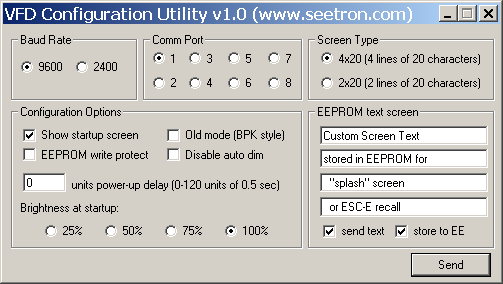VFD-x20 Configuration Tool
DISCONTINUED: REFERENCE ONLY
VFD-x20 displays store settings in nonvolatile EEPROM. You can configure the VFDs either by using escape instructions or with the Windows utility available from seetron.com. This document describes the software.
When development is complete, you can order VFD-x20s pre-configured with your settings. Email tech@seetron.com for more information.
System Requirements
The VFD configuration tool runs on any PC with Windows '95 through Windows 7. It requires the use of an RS-232 serial port or USB adapter. (If a USB adapter is used, an external power supply will still be needed; the VFDs draw more current than USB can source.)
Downloading and Installing the Tool
Download the ZIP file containing the program here. Unzip it to a convenient location (directory on your hard drive, flash drive, etc.). Space required is less than 100kB.
Vista and Later Security Alert
The VFD tool makes no changes to your system configuration, registry, etc. Under Vista, Win 7 and later, it may cause an "Unknown Publisher" alert; this is not an issue so long as you're certain that the files were downloaded from seetron.com. If in doubt, download a fresh copy from seetron.
Using the Configuration Tool
Before using the configuration tool, make sure VFD is in the config mode by setting switch (1) on the interface board ON.
Connect the VFD to the PC serial (comm) port and power. Double-click vfd_cfg.exe for the following screen:

Pick the options you want, set the correct comm port number and click Send. Options take effect after the power has been turned off and back on.
Settings
Baud Rate Set to match VFD switch (2): OFF= 2400bps, ON= 9600bps.
Comm Port Port number to which the display is connected.
Screen Type Set to match the display model, -420 or -220.
Configuration Options
Show Startup Screen Tells the VFD to display your stored text screen upon power up.
EEPROM Write Protect Prevents a runaway program from possibly overwriting your stored screen.
Old Mode Enables use of programs written for VFDs interfaced to BPK-type driver boards. Do not enable this option unless you know you need it. It invalidates all of the programming instructions in the manual. It's available for users of our mid-1990s displays. (Yes, we take backward-compatibility seriously.)
Disable Auto Dim Default behavior of the VFDs is to reduce display brightness by 25% for every 100 seconds of inactivity; i.e., no serial input. The display never blanks completely; the process stops at 25%. Auto dimming extends the life of the VFD, which can suffer burn-in if left displaying a fixed message for a long time at high brightness. You may disable this feature by checking this box (your program can always manage the VFD brightness itself using the appropriate ESC code).
Power-up Delay Causes the display to ignore serial input for up to a minute after power-on. This can be used to prevent garbage characters that might be sent by some (typically older) systems when they initialize serial ports at startup. Enter 0 or the desired delay in units of ½ second.
Brightness at Startup Sets the initial brightness, which can be changed later via an ESC instruction.
EEPROM Text Screen
Text Input boxes wrap at 20 characters per line. Only ordinary text is supported, no custom/big characters.
Send Text Unchecking this box prevents the text from being sent/saved; i.e., in case you wish to download only config options and not a screen.
Store to EE Unchecking this box prevents the screen from being saved to EEPROM. For example, you could choose to send the text, but not memorize it in order to preview a screen before saving it.
"Send" Button
Pressing Send bundles up your options and text and transmits them serially to the display, wrapped up in appropriate ESC codes. Configuration settings take effect after next power-ON. To prevent accidental alteration of settings, you must turn switch (1) OFF.

